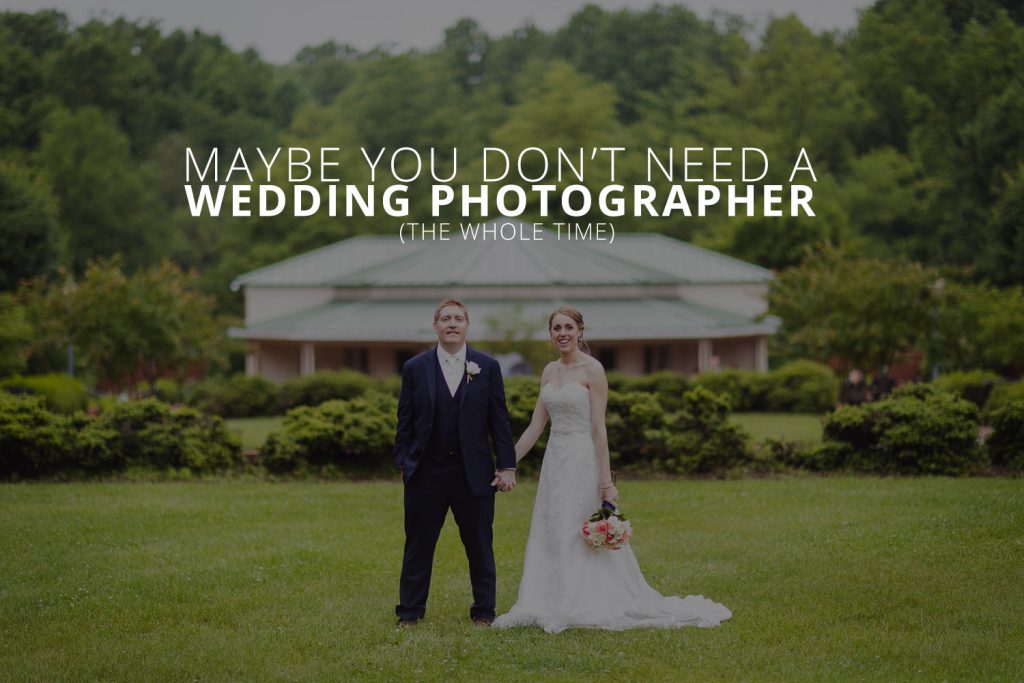You know, I’ve been a photographer for more than 10 years now and I’ve seen plenty of stuff change. I got into this industry shortly after digital cameras overtook their film counterparts. Over the years, digital cameras at almost every level, have gotten better. My niece’s toy camera has better resolution than my first point and click digital. Holding one of my pro cameras, my nephews can take better pictures than I could when I first started out. The average person is almost as capable of creating a good photo as a seasoned photographer 20 years ago would have been. A lot of couples are logically extrapolating this transition into their wedding, relying on less and less skilled photographers to cover their wedding day, and sometimes, just relying on guests to do it.
While a lot of photographers are starting to sweat, I’m seeing it as both a good thing and a bad thing. It’s good because it means that more couples are thinking critically and practically for their long term—perhaps you don’t need to spend $6k on a wedding photographer; maybe that money would be better added to the down payment on a house, or on a baby fund they expect to dive into eventually. But, simultaneously, it’s a negative thing because it means more people are getting sub par work; the photographer you can afford to be there the whole day for $1500 is generally more likely to disappoint you than a more expensive one. It seems like an unfortunate dichotomy: Spend more than you can afford, or risk photos of extreme importance to you. But, I think I have a better way.
So, I’d like to try and unpack this as even handedly as I can to help you understand these decisions, and propose a better compromise than just hiring a cheaper shooter off craigslist or something. But first, I want to take a second and remind you that none of this wedding stuff is “normal” or “traditional”, strictly speaking. Much of that was made up by the budding wedding industry in the last 40 years. Weddings have changed dramatically, from something that was once a family affair in your back yard, to the opulent ideals put forth in wedding magazines.
Nothing has to be “just so”. It’s entirely up to you, and finding the right mix of what you want, what you can afford, and what’s absolutely critical for you, is the underlying task of every couple planning a wedding. So, perhaps this is for you, perhaps it’s not. But take it under consideration.
What’s the hard part of wedding photography?
What’s the hard part of wedding photography? This question, obviously, doesn’t have any one answer. There are a lot of photographers out there. But, I can tell you from experience with myself, and many different shooters over the years, that the hardest parts of wedding photography are A) the soft-skills, and B) the unexpected.
The soft-skills in this context are things like working with a really big group of people without getting flustered or frustrated; Getting interesting angles during a church ceremony, without being disruptive; Moving through formal photos with the wedding party quickly, and being sure they’re having fun in the process; Capturing the couple looking natural in their post ceremony portraits. The “unexpected” is when your photographer has less time, or light, or space, or cooperation than was anticipated. These things are much more likely to make-or-break your photographer’s performance than any technical challenge they might face with their camera, or the grand philosophies of “photography”. And, they’re the hardest of the skills to actually acquire.
Soft-skills, and fortitude through the unexpected, are incredibly important for a wedding photographer to have… sometimes. The fact of the matter is, someone who’s good with a camera doesn’t need super good soft-skills to photograph the wedding preparations and getting into the dress. And, while wedding photographers often say they have to be “ready for anything” during a wedding reception, they really mean they have to be “ready for anything to get the best possible photo”.
But, you don’t necessarily need “the best possible photos” during the reception. And, you don’t necessarily need the most socially fluid person to get really nice photos of your wedding preparations.
Just prioritize the most important images!
So what are we really talking about here? I’m saying that the two parts of the wedding where a photographer’s soft-skills, and their ability to deal with the unexpected, are the absolute most important, are while shooting portraits (family formals, couples formals, wedding parties, etc), and during the ceremony. It’s photos from these parts of the wedding that you’re the most likely to see hanging on the wall, or sitting on the mantle. These are the photos that are the most likely to become iconic in the history of your family. It’s these images that will pack the most nostalgic punch, reminding you of a more encompassing time in life than the specificity of the hotel room or the reception hall would naturally suggest.
Almost no one is working on an infinite wedding budget, and finding ways to bring the cost down without threatening those highly important images is difficult. But, you don’t really have to treat it so linearly. While you may not be able to afford an experienced photographer for 10 hours, you can probably afford to hire them for 3 hours, to cover the most critical images, where the quality and creativity really matter a lot in the long run.
Maybe if you really think about it, that’s all you really need to do to be satisfied years from now. Or, maybe you’d still like images from those other parts of the wedding. I wouldn’t blame you! But at this point, with your most critical images in sure hands, you can much more comfortably hire an amateur or semi-pro to cover the other parts of the wedding.
Simply having them there with no other job than to take pictures will mean you’ll get a visual record of everything—even if it’s not the most brilliantly creative or expertly processed. I wouldn’t recommend relying on your guests to make the visual record for you, even if you have a great photographer covering your ceremony and formals. When they do it, it can definitely be good enough to help you remember and smile. But… they often just don’t do it. So, unless you put a lot of planning into getting your guests to make the visual record for you, don’t bank on that happening.
Complexity is a matter of perspective here
As I said before, this concept is not for everyone. And in truth, it does complicate your planning a bit. At least on the surface. Let me explain what I mean.
Hiring a photographer is difficult primarily because there are so many of them, and saving money while being sure you’re hiring someone whose qualified takes time and can mean interviewing a bunch of different people. If you find them, excellent. But it takes a considerable amount of energy; you don’t want to jeopardize those images. Contrast that with the comparatively few photographers who are highly qualified, and you realize it’s fairly easy to find the right one, and afford them in the degree you need. Following that, any amateurs or semi-pros you consider won’t need to be scrutinized quite as hard because they aren’t responsible for the most important images.
In terms of net energy used, finding and hiring one highly qualified professional for the key images, and one amateur or semi-pro for the rest of them, may be easier than carefully vetting dozens of different full coverage options.
In addition to full scale and traditional wedding packages, Petruzzo Photography also offers packages specifically designed for Ceremony & Formals Coverage Only, and we may even be able to help pair you with an amateur or semi-professional third-party to cover the rest of your event. If you think this approach to your wedding day might be a good fit for you and your values, check out our wedding services page for more information!

